Last updated on
Discover the perfect cabinets for your kitchen island as we delve into a variety of stylish and functional options to elevate your culinary space.
The kitchen is the heart of every home, and a kitchen island is the centerpiece that ties it all together. It serves as a multi-functional space for meal prep, cooking, dining, and entertaining.
But with so many options available in the market, selecting the right cabinets for your kitchen island can be overwhelming. Fear not! In this article, we will guide you through the process of choosing cabinets that are both functional and aesthetically pleasing for your kitchen island.
So let’s dive in!
What's Inside
Types of Kitchen Island Cabinets
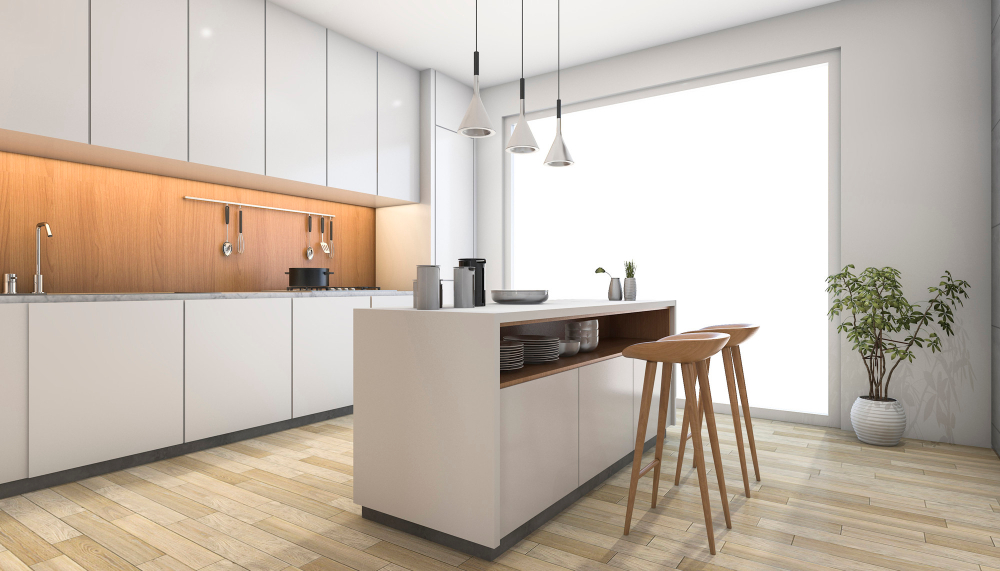
When it comes to kitchen island cabinets, there are several types to choose from. The most common options include base cabinets, wall-mounted cabinets, and custom-built cabinetry.
Base cabinets are the most popular choice for kitchen islands as they provide ample storage space and can be easily customized with drawers or shelves. Wall-mounted cabinets offer a sleek look but may not be as functional for an island unless you have limited floor space.
Custom-built cabinetry is another option that allows you to create a unique design tailored specifically to your needs and preferences. This type of cabinet offers endless possibilities in terms of size, shape, material selection, color scheme and hardware choices.
Custom Vs. Stock Cabinets for Kitchen Islands
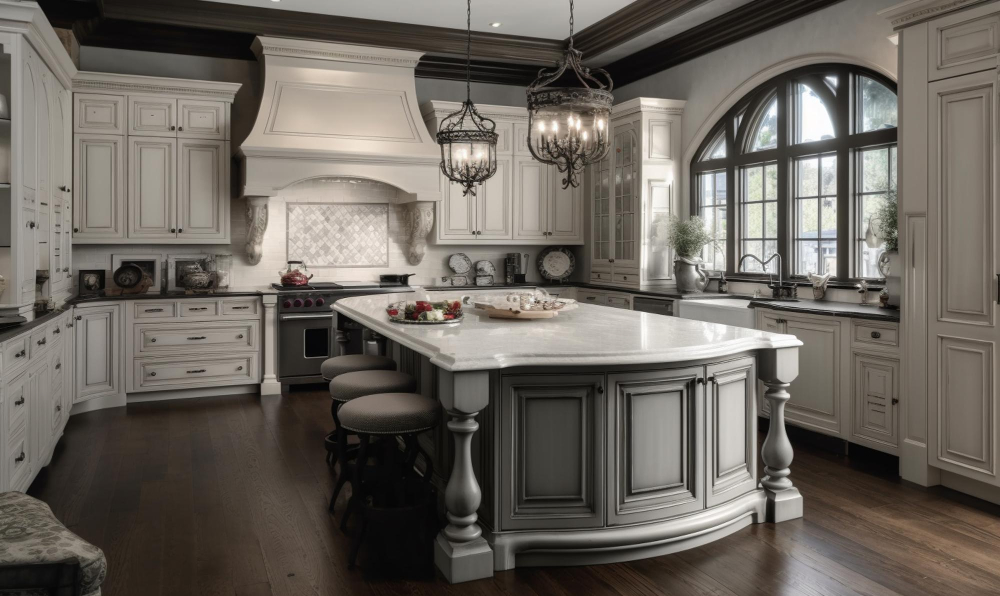
Custom cabinets are made-to-order and designed specifically for your space, while stock cabinets come in pre-made sizes and designs that can be easily installed.
Custom cabinetry offers the advantage of being tailored to fit your unique needs and preferences. You can choose from a wide range of materials, finishes, colors, hardware options as well as incorporate functional features such as pull-out drawers or built-in appliances.
However, custom cabinetry is often more expensive than stock because it requires specialized craftsmanship.
On the other hand, stock cabinetry is readily available at home improvement stores with a variety of styles and finishes to choose from at an affordable price point. Stock cabinet manufacturers offer standard sizes that make installation easier but may not fit perfectly into every kitchen layout.
Ultimately the decision between custom vs.
Choosing the Right Size Cabinets
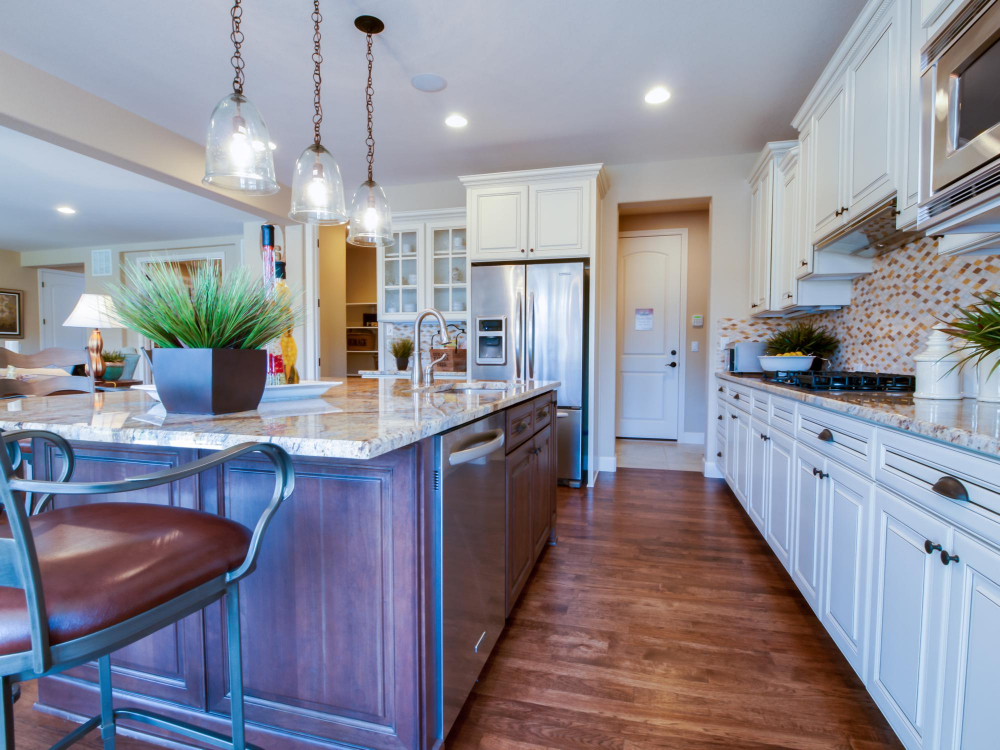
First and foremost, you need to determine the size of your kitchen island. The cabinets should be proportionate in size and scale with the overall dimensions of your island.
If you have a small kitchen or limited space for an island, then opting for smaller-sized cabinets is ideal. However, if you have ample space available in your culinary area and want to make a statement with larger cabinetry on your island – go big!
Another factor that affects cabinet sizing is functionality. If you plan on using some of these drawers as storage spaces or even seating areas (with overhangs), then ensure that they’re large enough so people can sit comfortably without feeling cramped.
Can You Use Base Cabinets for a Kitchen Island?

The answer is yes! Base cabinets are an excellent option for creating a sturdy and functional kitchen island. They come in various sizes and styles, making them versatile enough to fit any design aesthetic.
Using base cabinets also allows you to customize your island’s storage space according to your needs. You can add drawers, shelves, or even pull-out trays that make accessing pots and pans more convenient while cooking.
However, keep in mind that using base cabinets may limit some design options such as incorporating open shelving into your kitchen island’s layout. If you plan on having seating at your kitchen island with overhangs on either side of the cabinet run then consider adding support brackets underneath these areas so they don’t sag over time.
Matching Island Cabinets to Perimeter
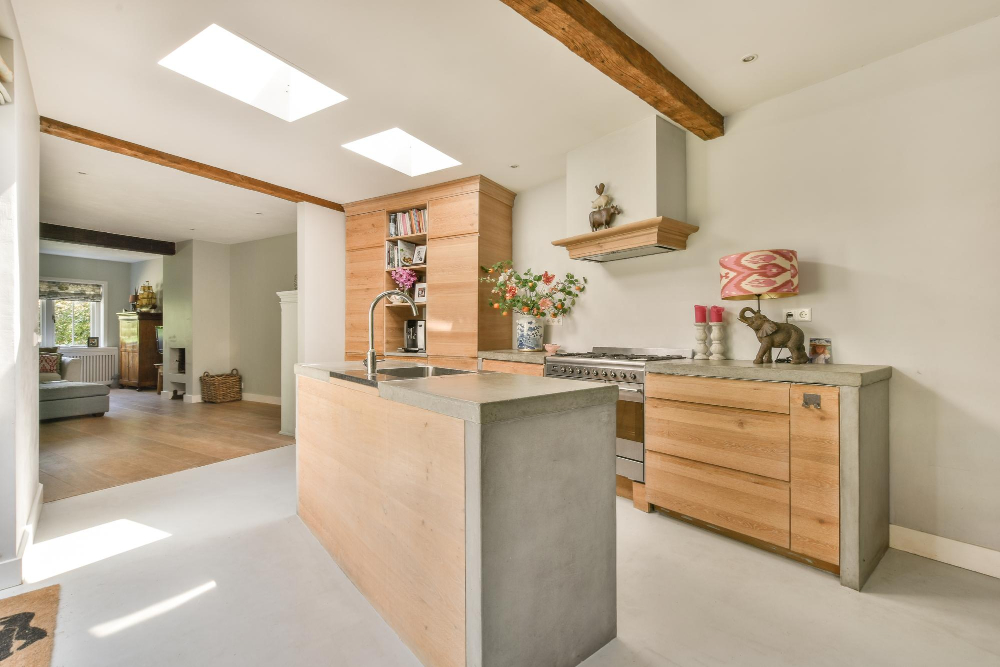
Matching your island cabinets to perimeter cabinets can create a cohesive look that ties everything together. To achieve this, you need to consider factors such as cabinet style, color and finish.
If you have existing cabinetry in your kitchen, try matching the style and finish of your new island cabinets with those already installed. This will help maintain consistency throughout the space while adding an element of interest.
Another option is choosing complementary colors or finishes for both sets of cabinetry. For instance, if you have white shaker-style perimeter cabinets in matte finish then opt for navy blue or grey-blue painted base cabinet on an island which would add depth and contrast without being too overwhelming.
Choosing the Right Material

The most popular materials include wood, laminate, metal and glass. Wood is a classic choice that adds warmth and character to any space.
It’s also durable and can be stained or painted in various colors.
Laminate is another option that offers versatility in terms of color and texture while being budget-friendly. Metal cabinets provide an industrial look that works well with modern decor styles but may not be suitable for traditional kitchens.
Glass-fronted cabinets add elegance to any kitchen island design by showcasing decorative items or dishware inside them while keeping them protected from dust.
Consider the overall style of your kitchen when selecting cabinet materials as they should complement each other seamlessly without clashing with other elements such as countertops or flooring.
Open Shelving Vs. Closed Cabinets

Open shelving is a popular choice for those who want to showcase their beautiful dishware and decorative items. It also creates an airy and spacious feel in the kitchen.
However, it requires regular cleaning as dust can accumulate on exposed items.
On the other hand, closed cabinets provide ample storage space while keeping everything hidden from view. This is ideal if you prefer a clutter-free look or have young children at home who may be tempted to touch breakable objects on open shelves.
Ultimately, whether you choose open shelving or closed cabinets depends on your personal preference and lifestyle needs.
Incorporating Functional Features
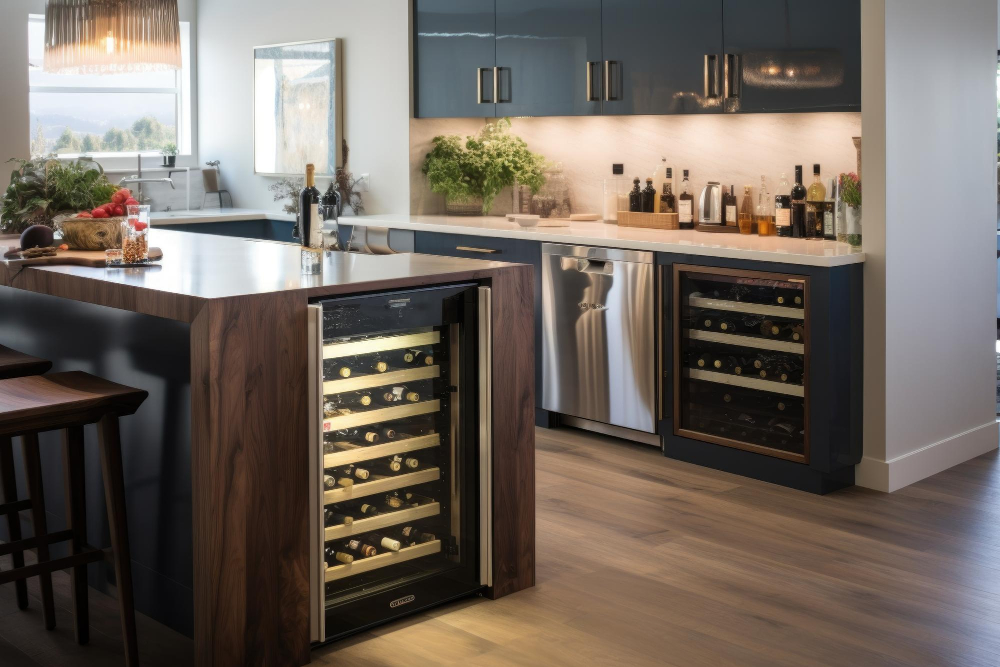
Incorporating functional features into your cabinet design can make all the difference in how you use and enjoy your kitchen space. Consider adding pull-out drawers for pots and pans, built-in spice racks or utensil holders for easy access while cooking.
You could also include a wine rack or mini-fridge if you love entertaining guests.
Another popular feature is incorporating electrical outlets into the cabinetry so that appliances like blenders, mixers, and toasters can be used without having cords cluttering up counter space. Installing lighting underneath cabinets will provide ample illumination when working on meal prep tasks.
Popular Kitchen Island Cabinet Styles
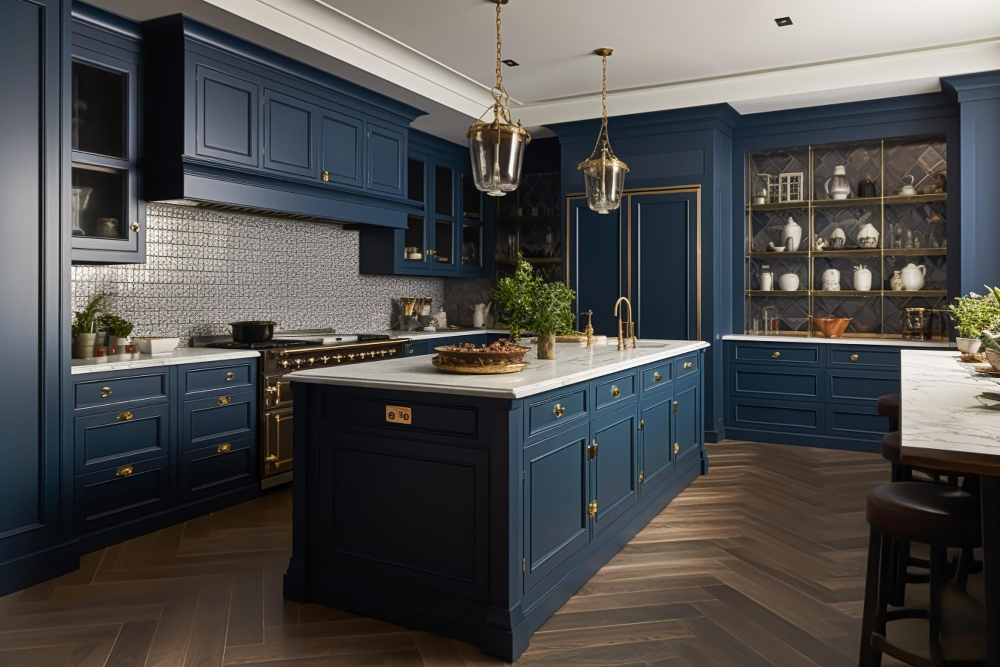
The style you select will depend on your personal taste and the overall design aesthetic of your home. Some popular cabinet styles for kitchen islands include traditional, modern, rustic, and farmhouse.
Traditional-style cabinets feature ornate details such as raised panels or decorative molding that add elegance and sophistication to any space. Modern-style cabinets have clean lines with minimal ornamentation for a sleek look that complements contemporary homes.
Rustic-style cabinets incorporate natural materials like wood or stone with distressed finishes for an earthy feel that brings warmth into the room. Farmhouse-style cabinetry is similar but often features beadboard paneling or shiplap accents in addition to rustic elements.
Selecting Color and Finish

The color and finish you choose can also affect how easy it is to maintain your cabinets over time.
When selecting a color, consider whether you want to match or contrast with the perimeter cabinetry. If you’re going for a monochromatic look, choose an accent shade that’s slightly lighter or darker than the surrounding cabinetry.
For those who prefer contrasting colors, opt for complementary shades on opposite sides of the color wheel.
The finish of your cabinet doors will also impact their durability and maintenance requirements. High-gloss finishes are sleek but show fingerprints easily while matte finishes hide smudges better but may require more frequent cleaning to keep them looking pristine.
Hardware Selection for Island Cabinets

The right hardware can add a touch of elegance, sophistication, or even rustic charm to your kitchen island.
When selecting hardware for your island cabinets, consider the style and finish that will complement the rest of your kitchen decor. If you have stainless steel appliances in other parts of the room, brushed nickel or chrome handles may be an excellent choice to tie everything together.
Alternatively, if you’re going for a more traditional look with wood cabinetry throughout most areas in the room but want something unique on just this one piece – try antique brass pulls which will give it some character without being too flashy!
Remember that functionality is also important when choosing cabinet hardware. Make sure that whatever knobs or pulls you select are comfortable to grip and easy to use regularly.
Tips for Maximizing Storage Space
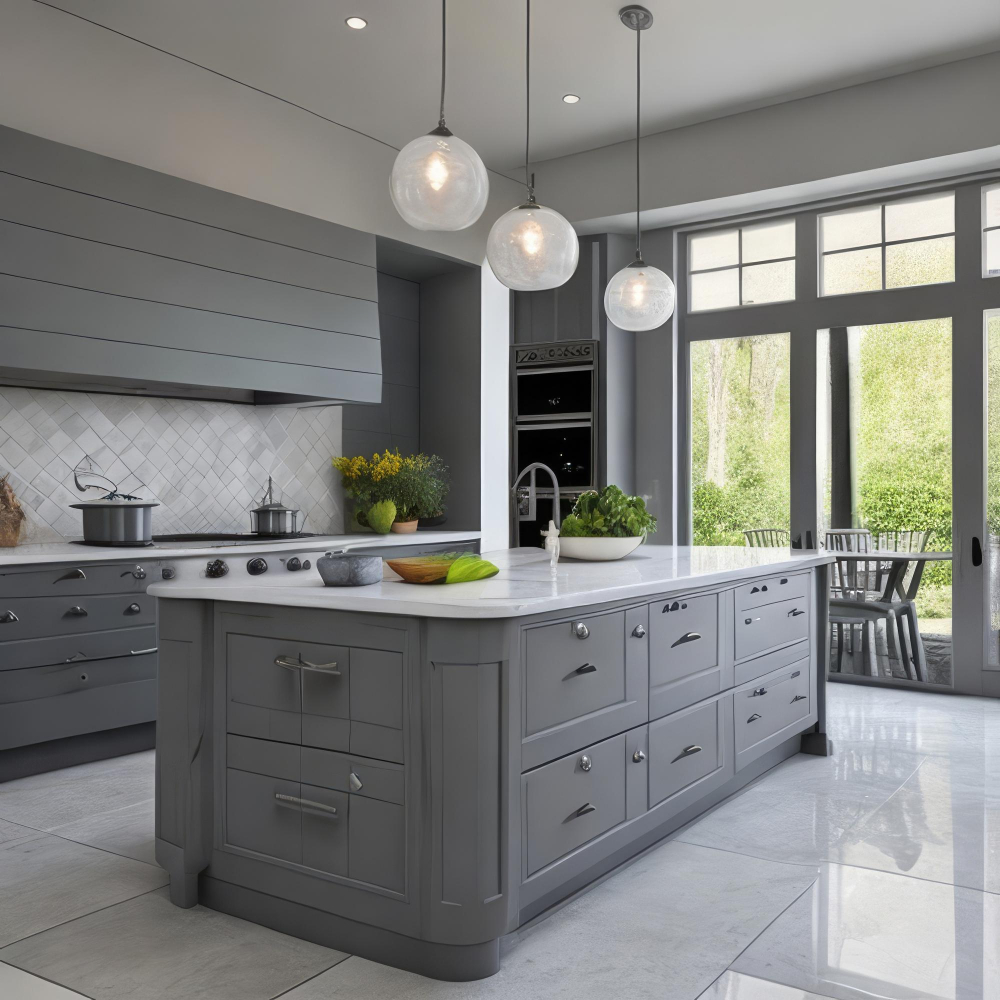
You want your island cabinets to be both functional and stylish. Here are some tips for maximizing storage space in your kitchen island:
1. Utilize pull-out drawers: Pull-out drawers provide easy access to items stored at the back of the cabinet.
2. Install vertical dividers: Vertical dividers can help organize baking sheets, cutting boards, and other large flat items.
3. Add a spice rack: A built-in spice rack keeps spices organized and easily accessible while cooking.
4. Incorporate open shelving: Open shelves allow you to display decorative pieces or frequently used dishes while keeping them within reach.
5. Use corner cabinets wisely: Corner cabinets can be tricky but installing lazy susans or swing out trays will make use of this often wasted space.
Installing Kitchen Island Cabinets
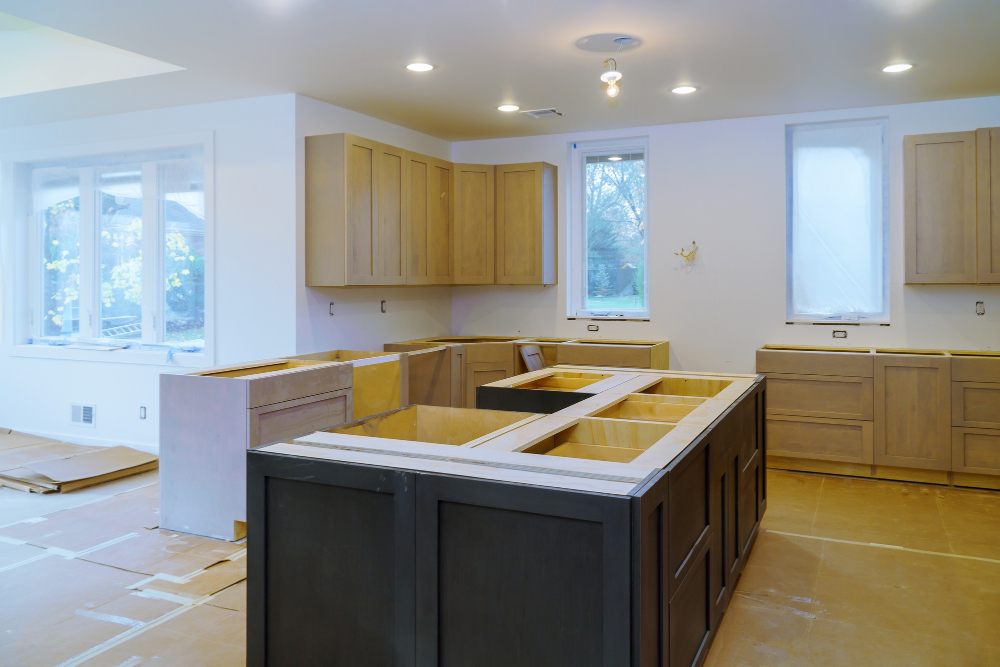
Installing kitchen island cabinets can be a challenging task, but with the right tools and guidance, it can be done efficiently.
Firstly, determine where you want to place your kitchen island and measure the space accurately. Next, mark out where each cabinet will go using painter’s tape or chalk lines on the floor.
Begin by installing base cabinets first as they provide stability for upper cabinetry. Attach them together using screws through pre-drilled holes in their sides and secure them to the floor with brackets or shims if necessary.
Next up is attaching upper cabinetry onto base units securely while ensuring that everything is levelled correctly before screwing into place from inside of each cabinet box at top corners down into lower ones below (or vice versa).
Maintenance and Care of Island Cabinets

Regular cleaning will help keep the cabinets looking new and prevent damage from spills or stains. Use a soft cloth or sponge with mild soap and water to wipe down the cabinet surfaces regularly.
Avoid using abrasive cleaners, as they can scratch the surface of your cabinets. Also, be careful not to use too much water when cleaning around sink areas as this can cause warping over time.
In addition to regular cleaning, it’s essential that you inspect your island cabinets periodically for any signs of wear or damage such as loose hinges or handles. If you notice any issues with your cabinetry, address them promptly before they become more significant problems.
Determine Kitchen Island Placement and Size
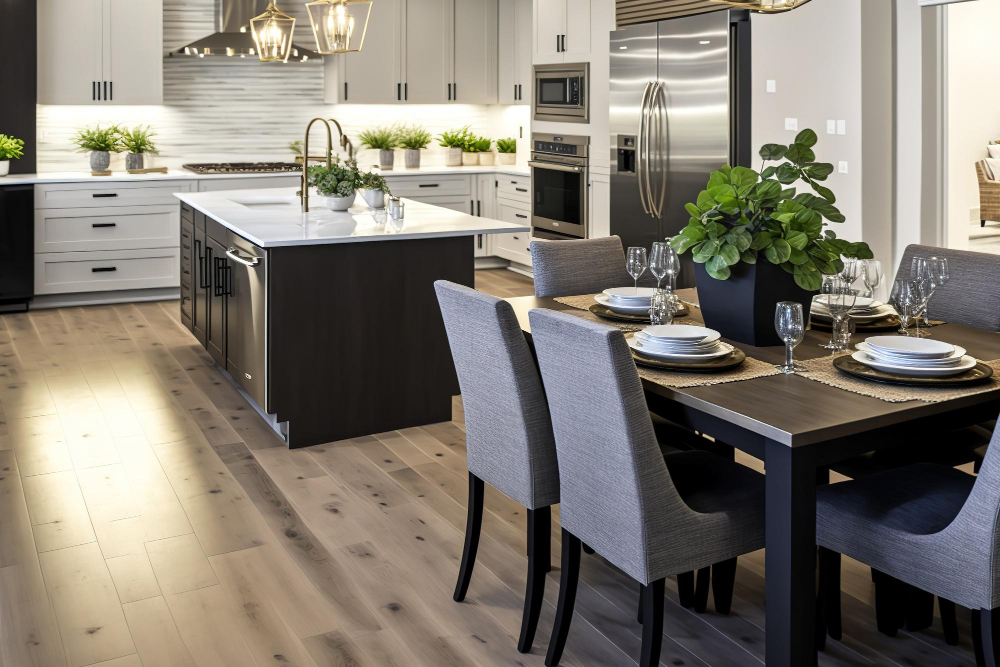
The location of your kitchen island will depend on the layout of your kitchen and how you plan to use it. If you’re using it primarily for meal prep, then placing it near the stove or sink is ideal.
On the other hand, if you want to use it as a dining area or entertaining space, then positioning in an open area with ample seating room would be more appropriate.
When determining size, consider both functionality and aesthetics. You don’t want an oversized island that takes up too much space in a small kitchen nor do you want one that’s too small for larger kitchens where there is plenty of room available.
Once placement and size are determined based on these factors; traffic flow patterns should also be taken into account so that people can move around freely without bumping into each other while cooking or serving food at gatherings.
Create a Kitchen Island Plan Using Stock Cabinets
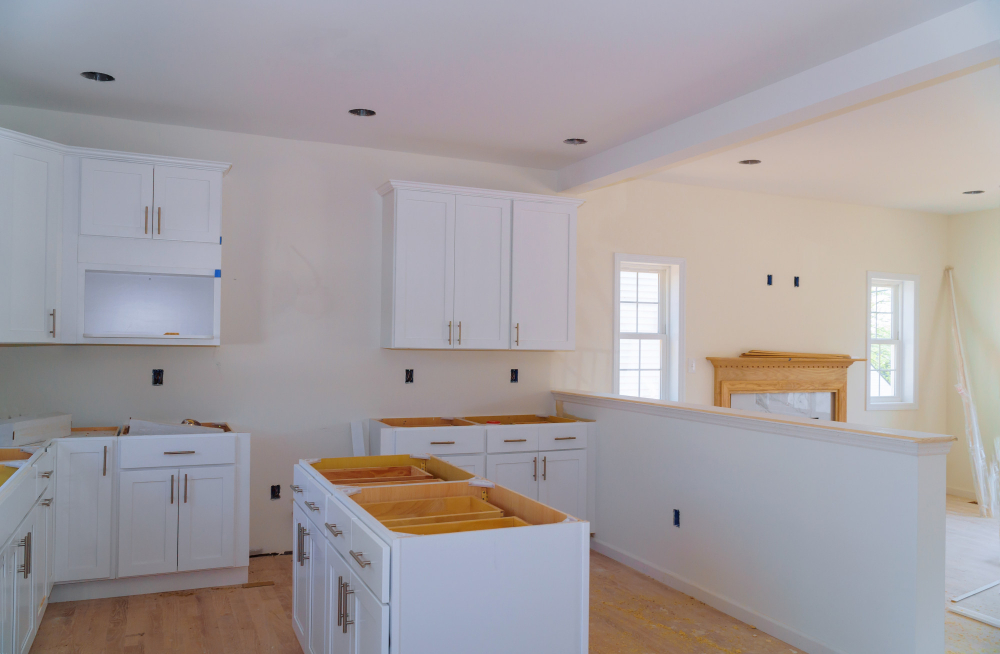
They come in standard sizes and finishes, making it easy to mix and match to create the perfect look for your space. To get started with this approach, first determine the size of your island by measuring the available space in your kitchen.
Then select base cabinets that fit those dimensions.
Next, consider how many drawers or shelves you’ll need based on how you plan to use the island. For example, if it’s primarily used as a prep station while cooking meals then more drawers may be necessary than open shelving.
Once you have selected all of the necessary components for building out your kitchen island using stock cabinets – including any additional features like pull-out trash cans or built-in wine racks – it’s time to put everything together! With some basic tools and DIY skills (or help from a professional), assembling these pre-made pieces is relatively straightforward.
Be Creative With Your Kitchen Island Cabinets
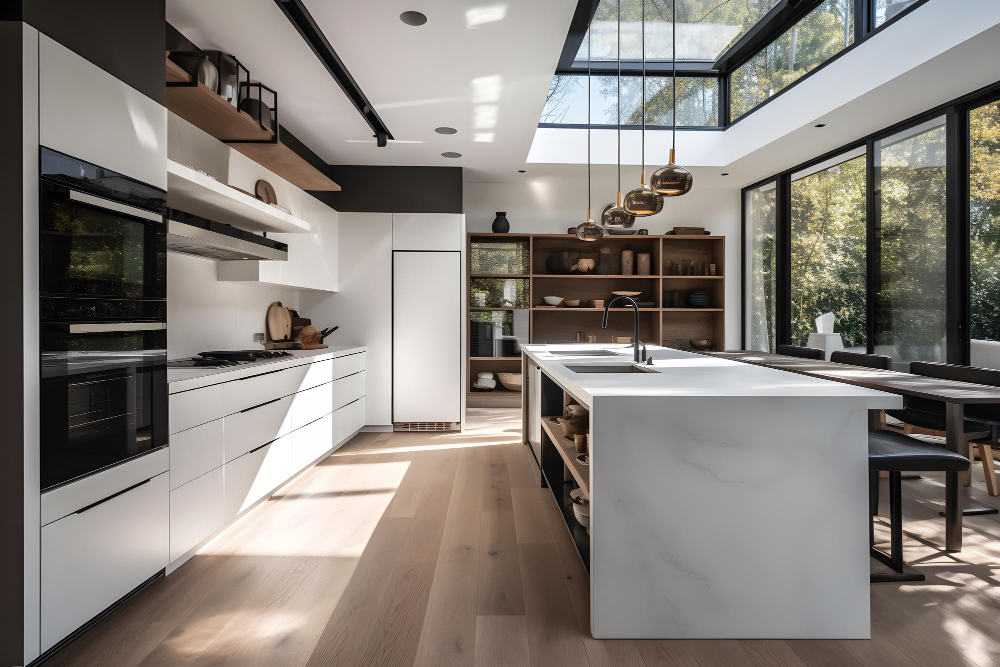
You can mix and match different cabinet styles or colors for a unique look. For example, you could use open shelving on one side of the island and closed cabinets on the other side.
Or you could incorporate glass-fronted cabinets to showcase your favorite dishes or decorative items.
Another way to add some personality is by choosing interesting hardware for your kitchen island cabinets. From sleek modern handles to vintage-inspired knobs, there are countless options available that can make a big impact.
If you’re feeling particularly adventurous, consider adding some unexpected features like built-in wine racks or pull-out spice drawers. These functional additions not only enhance the usability of your space but also add an element of surprise and delight.
Connect the Cabinets for Your Island
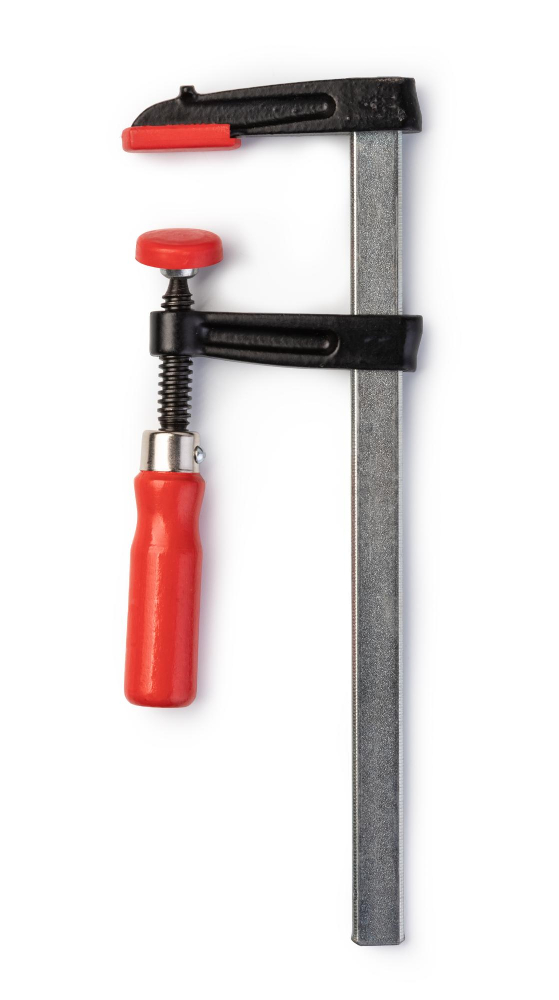
Connecting the cabinets is an essential step in ensuring that your island is stable and secure. To do this, you will need a few tools such as screws, clamps, and wood glue.
Start by placing the base cabinet on its backside so that you can access its underside easily. Then take another cabinet and place it next to the first one with their sides touching each other.
Use clamps to hold them together tightly.
Next up is drilling pilot holes through both of these cabinets’ frames where they meet at their sides using a drill bit slightly smaller than your screws’ diameter size.
Apply some wood glue along with these edges before screwing them together firmly using long screws into those pilot holes drilled earlier until they are flush against each other without any gaps or spaces between them.
Attach the Base Cabinets for Stability
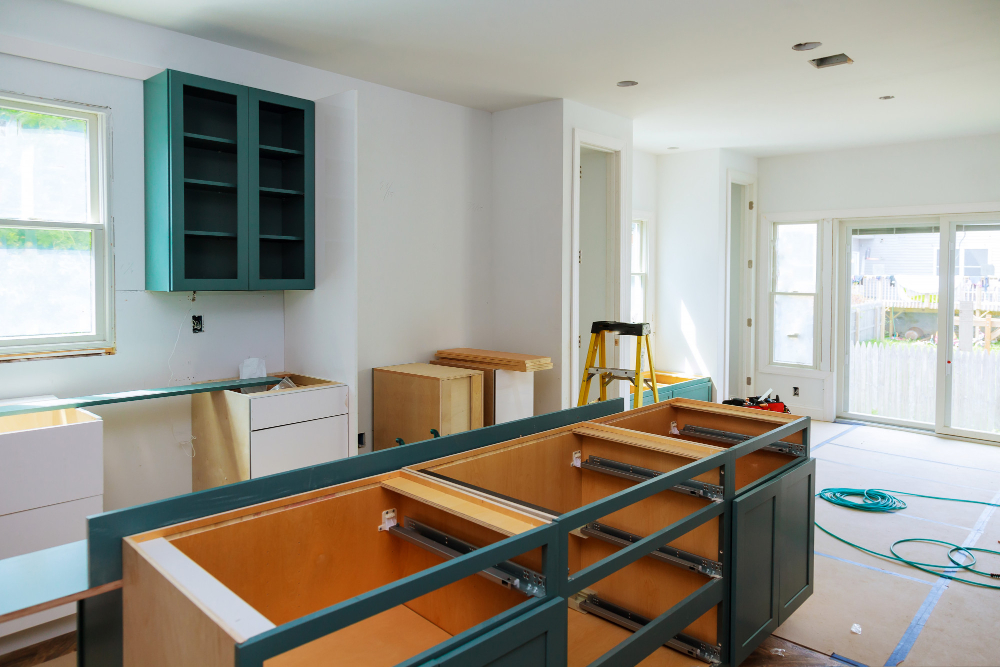
Attaching the base cabinets is a crucial step in ensuring stability and durability of your kitchen island. Start by placing the first cabinet in its designated spot and use shims to level it if necessary.
Then, drill pilot holes through both sides of each cabinet where they will be joined together with screws.
Next, attach adjacent cabinets using wood screws that are long enough to penetrate both pieces but not so long as to protrude out from inside or damage any plumbing or electrical work underneath. Repeat this process until all base cabinets are securely attached.
It’s important to note that proper installation of base cabinets is essential for maintaining structural integrity and preventing sagging over time due to weight distribution on top of the island surface.
Put the Countertop in Place On Your Kitchen Island
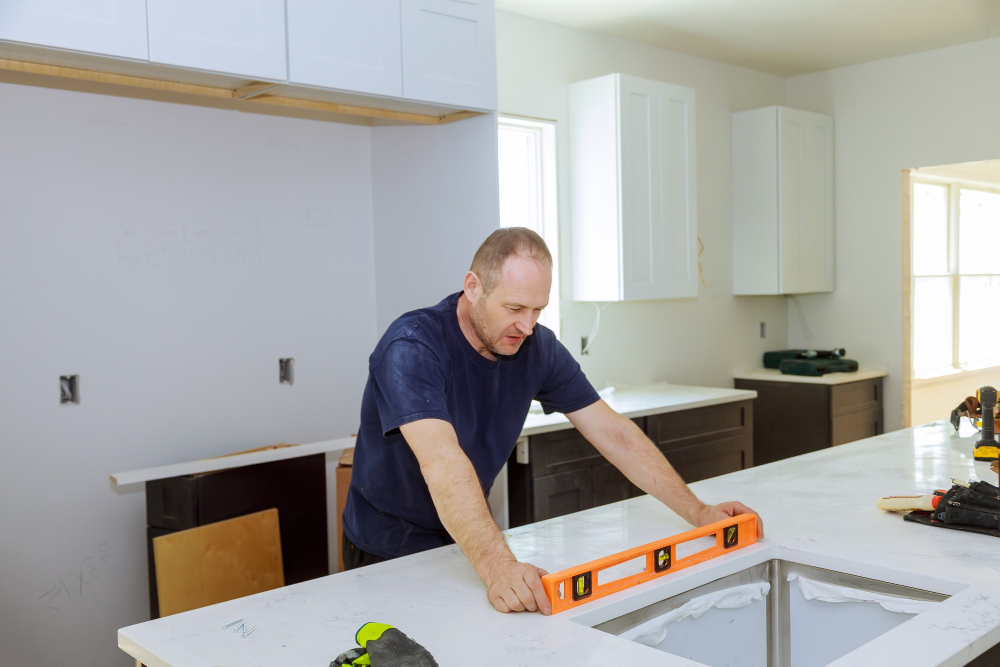
The countertop is a crucial element of your kitchen island as it provides a functional workspace and adds to its overall aesthetic appeal. Before installing the countertop, ensure that all base cabinets are level and securely fastened together.
To install the countertop, carefully lift it onto the base cabinets and align it with precision. If necessary, use shims or filler strips to fill any gaps between adjacent countertops or walls.
Next, secure the countertops in place using screws from underneath through corner brackets or L-brackets attached to both cabinet frames and underside of counter surface at each corner. Be sure not over-tighten screws as this can cause damage such as cracking or splitting on delicate materials like granite.
Apply silicone caulk around edges where counters meet walls for added stability against moisture penetration which could lead mold growth over time if left unchecked!
FAQ
What cabinets should be in a kitchen island?
Kitchen islands should have base cabinets, as they are durable, offer ample storage space, and can support various countertop materials.
Can you use wall cabinets for an island?
Yes, wall cabinets can be used on the back end of the island to add space for kitchen seating, alongside base cabinets, to create a functional kitchen island.
Should your kitchen island match your cabinets?
Your kitchen island does not have to match your cabinets, as using different colors or materials can create a complementary focal point in the space.
What factors should be considered when selecting cabinets for a kitchen island?
The factors to consider when selecting cabinets for a kitchen island include available space, storage needs, budget, and aesthetic preferences.
How can you effectively utilize the storage space within a kitchen island cabinets?
To effectively utilize the storage space within a kitchen island cabinets, use organizing tools like shelves, pull-out drawers, dividers, and hooks.
Are there any specific materials or finishes recommended for kitchen island cabinets to ensure longevity and functionality?
For kitchen island cabinets, using durable materials like hardwood, plywood, or MDF, and finishes such as laminate, thermofoil, or paint is recommended to ensure longevity and functionality.




